Between 2025 and 2035, the anode refining furnace market is projected to grow from USD 379.6 million to USD 525.1 million, at a compound annual growth rate (CAGR) of 3.3%, establishing a solid foundation for sustained expansion across global copper processing operations. The initial growth phase demonstrates steady momentum building, with market value climbing from USD 392.1 million in 2026 to USD 446.5 million by 2030. This foundational period reflects increasing copper demand and expanding electrolytic refining capacity requirements across emerging and developed mining regions.
The maturation phase witnesses consistent growth dynamics, propelling the market from USD 461.2 million in 2031 to reach USD 525.1 million by 2035. Dollar increments during 2030-2035 maintain steady progression, with annual value additions averaging USD 15.7 million compared to USD 13.4 million in the foundational phase. This progression represents a 38.3% total value increase over the forecast decade.
Market maturation drivers include expanding copper production volumes, technological advancement in electrolytic refining processes, and recycling infrastructure development. The 3.3% compound annual growth rate positions market participants to capitalize on USD 145.5 million in additional value creation opportunities. This trajectory signals robust prospects for equipment manufacturers, technology providers, and copper processing facility developers across the global metallurgical landscape.
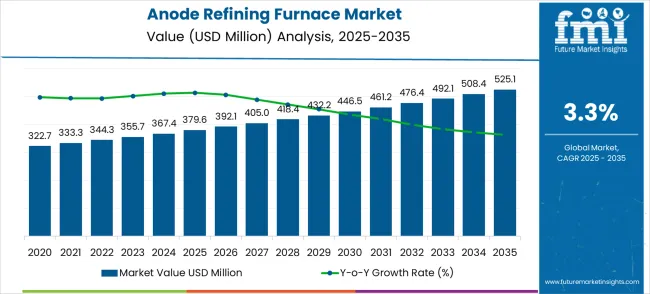
Market expansion unfolds through two distinctive growth phases with varying technological characteristics and development patterns. The 2025-2030 development period delivers USD 66.9 million in value additions, representing 17.6% growth from the baseline position. Market dynamics during this phase center on technology modernization, capacity expansion initiatives, and efficiency improvement adoption across copper smelting and electrolytic refining facilities worldwide.
The 2030-2035 consolidation period generates USD 78.6 million in incremental value, reflecting 17.6% growth from the 2030 position. This phase exhibits mature market characteristics with enhanced competition, technological differentiation strategies, and sustainability-focused expansion initiatives. Value contributions shift from foundational capacity development to operational optimization and advanced automation integration in next-generation copper processing facilities.
The competitive landscape evolves from emerging technology adoption to established market leadership positioning. The initial period emphasizes technological standardization and operational efficiency improvement within traditional copper refining applications. The subsequent period witnesses intensified competition for advanced technology segments and sustainable processing solution markets. Market maturation factors include standardized furnace specifications, automated operation integration capabilities, and cross-application development across primary copper production, recycling, and specialty alloy manufacturing sectors.
| Metric | Value |
|---|---|
| Market Value (2025) → | USD 379.6 million |
| Market Forecast (2035) ↑ | USD 525.1 million |
| Growth Rate ★ | 3.3% CAGR |
| Leading Segment → | Rotating Type |
| Primary Application → | Large-scale Copper Electrolytic Refining |
Market expansion rests on four fundamental shifts driving copper processing demand acceleration: 1. Expanding Copper Production Requirements: Global copper demand growth drives consistent expansion in primary production capacity and electrolytic refining infrastructure development. Mining operations require advanced anode refining capabilities for efficient copper processing and quality optimization. Industrial copper consumption increases necessitate enhanced processing efficiency and production capacity expansion across established and emerging copper producing regions. 2. Copper Recycling Infrastructure Development: Circular economy initiatives drive substantial investment in copper recycling facilities requiring specialized anode refining equipment. Secondary copper production expansion demands advanced furnace technology for processing recycled copper materials with varying contamination levels. Environmental regulations promote copper recycling through advanced processing technologies that minimize waste generation and energy consumption. 3. Technological Advancement in Metallurgical Processing: Industry 4.0 integration drives demand for automated and digitally controlled anode refining systems with enhanced operational efficiency. Advanced process control systems require sophisticated furnace technology for precise temperature management and composition control. Energy efficiency improvements necessitate next-generation furnace designs with reduced operational costs and environmental impact optimization. 4. Emerging Market Industrial Development: Developing economies experience rapid industrialization driving domestic copper processing capacity development and infrastructure investment. Automotive and construction sector growth in emerging markets increases local copper processing requirements for reduced import dependency. Infrastructure development projects necessitate reliable copper supply chains supported by domestic refining capacity and processing capabilities.
The market is segmented by product type into electric and manual formats, with electric variants accounting for 64.2% due to rising adoption of automated and efficient solutions, while manual types hold 35.8%, sustained by cost-sensitive and reliability-focused users. By application, automotive leads at 42.7%, followed by medical at 24.6%, aerospace at 19.8%, and other uses at 12.9%, highlighting strong demand in precision and safety-sensitive fields. Regionally, Asia Pacific dominates with China advancing at a CAGR of 9.3% and India at 8.6%, while Europe is led by Germany at 7.9%, and North America posts steady growth with the USA at 6.6%. Latin America, anchored by Brazil, grows at 7.2%, underscoring rising industrial and technological investments.
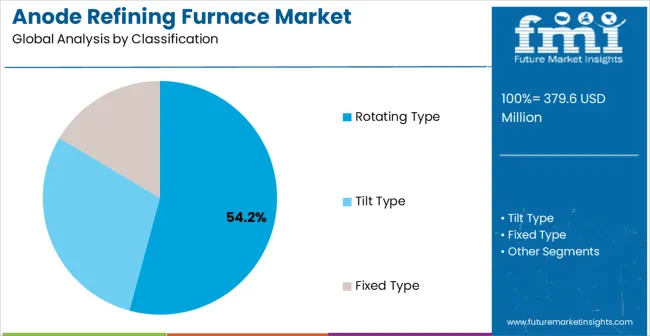
Market Position: Rotating anode refining furnaces establish clear market leadership through superior operational flexibility and processing efficiency benefits. Rotating systems eliminate material handling limitations in demanding high-throughput copper processing applications. Consistent rotation capabilities enable uniform heating distribution where stationary alternatives cannot achieve the required processing specifications.
Value Drivers: Advanced rotation mechanism technology improvements enhance material mixing uniformity and reduce processing time requirements. Digital control integration provides real-time temperature monitoring and rotation speed optimization. Specialized processing capabilities accommodate multiple copper grades within single operational configurations for enhanced productivity.
Competitive Advantages: Rotating systems offer enhanced processing efficiency compared to static alternatives requiring manual material handling procedures. Superior heat distribution increases processing throughput through reduced cycle times in high-volume operations. Premium pricing justification occurs through total operational cost advantages and productivity improvement benefits.
Market Challenges: Complex mechanical systems increase maintenance requirements compared to fixed furnace configurations. Quality control demands sophisticated monitoring equipment and technical expertise not available in all processing facilities. Limited supplier base creates supply chain vulnerabilities for specialized applications requiring consistent equipment availability and technical support.
Strategic Market Importance: Large-scale copper electrolytic refining represents the primary demand driver for advanced anode processing equipment across global copper production facilities. Primary copper production operations, integrated smelter complexes, and major refining installations require precise anode preparation for electrolytic cell optimization. Quality control standards mandate consistent anode composition and physical properties for electrorefining efficiency and product quality maintenance.
Market Dynamics Q&A:
Business Logic: Large-scale copper refining facilities prioritize operational efficiency and production capacity, making advanced anode refining furnaces essential for meeting production targets. Cost justification occurs through improved copper recovery rates and reduced processing cycle times. Quality assurance requirements demand consistent anode properties for optimal electrolytic refining performance.
Forward-looking Implications: Green copper production initiatives create new requirements for energy-efficient anode processing systems with reduced environmental impact. Advanced copper grade production demands enhanced anode quality control for specialized applications. Global copper demand growth sustains equipment demand across expanding production regions with developing mining infrastructure.
The anode refining furnace market is primarily driven by increasing global copper demand requiring superior processing efficiency and operational reliability. Applications in copper electrolytic refining, recycling operations, and specialty alloy production necessitate equipment that maintains consistent processing performance under demanding operational conditions, making advanced anode refining furnaces an essential solution. The integration of automation and digital control systems into copper processing operations further emphasizes the need for precise temperature control and process optimization, ensuring consistent product quality. Additionally, stringent environmental regulations across metallurgical sectors encourage the use of energy-efficient processing equipment that reduces operational costs and carbon emissions. Anode refining furnaces' compliance with industrial safety and environmental standards also makes them a preferred choice for critical copper processing applications, where documented operational performance is essential for regulatory compliance and safety assurance, creating a stable demand pipeline globally.
Despite its advantages, the anode refining furnace market faces several growth inhibitors. Capital investment costs are significantly higher than conventional processing equipment, discouraging adoption in cost-sensitive operations and smaller copper processing facilities. Moreover, the installation and commissioning processes are complex, requiring specialized technical expertise, comprehensive safety protocols, and sophisticated auxiliary systems, which are not universally available. Limited availability of skilled operators and maintenance technicians further constrains operational capacity expansion. Additionally, the technical complexity involved in operating and maintaining anode refining furnaces necessitates continuous training programs and specialized spare parts inventory, adding to operational overheads. Environmental compliance requirements collectively slow market penetration, particularly in emerging regions or environmentally sensitive sectors, restraining overall market growth despite rising copper industry demand.
The anode refining furnace market is evolving rapidly, driven by technological innovations and sustainability initiatives. Industry 4.0 integration enables precise control over processing parameters, thereby enhancing operational efficiency for specialized applications, including high-purity copper production, recycled copper processing, and advanced alloy manufacturing. Automation in furnace operations is another trend that reduces labor costs, improves process consistency, and minimizes operational risks. Sustainability and green metallurgy initiatives are gaining traction, prompting the development of energy-efficient processing methods that reduce environmental impact and operational costs. Furthermore, there is increasing demand for modular furnace designs tailored to specific processing requirements, offering operational flexibility while maintaining performance standards.
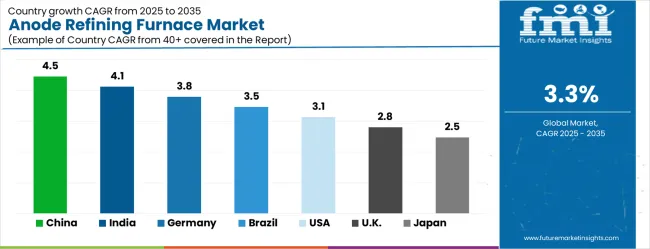
| Country | CAGR (%) |
|---|---|
| China | 4.5 |
| India | 4.1 |
| Germany | 3.8 |
| Brazil | 3.5 |
| USA | 3.1 |
| UK | 2.8 |
| Japan | 2.5 |
Global market dynamics reveal distinct performance tiers reflecting regional copper processing capabilities and industrial development levels. Growth Leaders including China (4.5% CAGR) and India (4.1% CAGR) demonstrate expanding copper production ecosystems with advanced processing technology adoption, while Germany (3.8% CAGR) represents European metallurgical excellence in precision applications. Steady Performers such as Brazil (3.5% CAGR) and the United States (3.1% CAGR) show consistent demand growth aligned with copper industry modernization and processing capacity requirements. Mature Markets including the United Kingdom (2.8% CAGR) and Japan (2.5% CAGR) display moderate growth rates reflecting established market penetration and technology advancement focus.
Regional synthesis indicates Asia Pacific dominance through copper production concentration and export manufacturing requirements. European markets emphasize technology excellence and environmental compliance in metallurgical applications. North American demand reflects industrial modernization adoption and sustainable processing development initiatives.
The report covers an in-depth analysis of 40+ countries top-performing countries are highlighted below.
China establishes market leadership through copper production sector dominance across integrated smelting operations, electrolytic refining facilities, and recycling processing installations. A 4.5% CAGR value reflects extensive production capacity and export-oriented copper manufacturing requirements driving consistent demand for high-performance anode refining equipment. Growth metrics demonstrate comprehensive copper industry modernization supported by government infrastructure development initiatives and stringent environmental improvement mandates across metallurgical sectors.
Market dynamics center on sustainable copper production expansion creating new high-efficiency anode processing requirements for enhanced energy efficiency and substantial emission reduction targets. State-owned enterprise modernization programs drive widespread adoption of advanced metallurgical equipment for operational efficiency improvement and international competitiveness. Export market demands necessitate strict international quality standard adherence through extensively documented performance specifications and certification processes.
Manufacturing concentration in major copper producing regions creates significant demand density for high-performance anode refining equipment and specialized applications. Industrial development policies specifically include advanced metallurgical equipment requirements for comprehensive technology upgrading initiatives. Foreign technology transfer partnerships bring international processing standards requiring advanced anode refining applications and technical expertise development.
Strategic Market Indicators:
India demonstrates robust growth potential through rapidly expanding copper processing capabilities and comprehensive government promotion of domestic metallurgical manufacturing initiatives under various industrial development programs. A 4.1% CAGR reflects increasing industrial sophistication and widespread technology standard adoption across copper processing sectors. Copper industry growth under government initiatives creates consistent demand for advanced anode refining equipment across both integrated copper complexes and specialty processing facilities.
Infrastructure development sector expansion drives significant secondary demand through stringent copper quality requirements for construction and telecommunications applications. Government industrial certification mandates actively promote advanced metallurgical equipment adoption for enhanced safety compliance and international standard adherence. Major infrastructure development projects substantially increase copper processing volumes requiring advanced anode refining applications and specialized processing systems.
Market activity centers on comprehensive technology transfer agreements bringing international copper processing standards and best practices to domestic manufacturing facilities. Foreign direct investment in copper operations introduces advanced anode refining requirements for improved operational efficiency and competitive advantage. Skill development initiatives include extensive training programs for advanced metallurgical equipment operation techniques and quality control procedures.
Market Intelligence Brief:
Germany maintains market leadership through exceptional engineering excellence and established precision metallurgical manufacturing traditions across diverse industrial sectors. A 3.8% CAGR demonstrates sustained market demand supported by an advanced industrial base with sophisticated copper processing capabilities and automotive industry requirements. Automotive sector expansion creates consistent demand for high-performance copper processing equipment across precision component manufacturing and advanced electrical system applications requiring superior metallurgical properties.
Industrial equipment manufacturing sector requires extensively certified equipment specifications for strict export compliance and international quality standards adherence. Engineering services sector utilizes premium metallurgical equipment for advanced prototype development and comprehensive testing applications requiring precise processing characteristics. Quality standard development significantly influences global metallurgical practices requiring advanced equipment adoption and technological innovation.
Advanced manufacturing research initiatives continuously develop innovative applications for anode refining furnaces across emerging industrial sectors. Export market leadership necessitates comprehensive quality documentation supporting international sales and regulatory compliance requirements.
Performance Metrics:
Brazil represents a significant emerging market with substantial growth potential, achieving a 3.5% CAGR through comprehensive industrial development initiatives and mining sector expansion across domestic and regional markets. The market reflects increasing metallurgical sophistication and widespread technology standard adoption driven by government policies promoting domestic copper processing capabilities. Mining industry modernization creates consistent demand for advanced anode refining equipment across integrated mining complexes and specialty processing facilities.
Automotive manufacturing growth drives primary market demand through domestic production expansion and regional export requirements for Latin American markets. Industrial equipment manufacturing sector expansion creates substantial opportunities for precision metallurgical applications and advanced processing solutions. Construction sector development significantly increases copper processing volumes requiring quality assembly capabilities and advanced processing systems.
Market development faces challenges including economic volatility affecting industrial investment decisions and currency fluctuation impacting imported high-performance equipment costs. Infrastructure development projects support manufacturing sector growth requiring precision processing capabilities and advanced metallurgical applications.
Strategic Market Considerations:
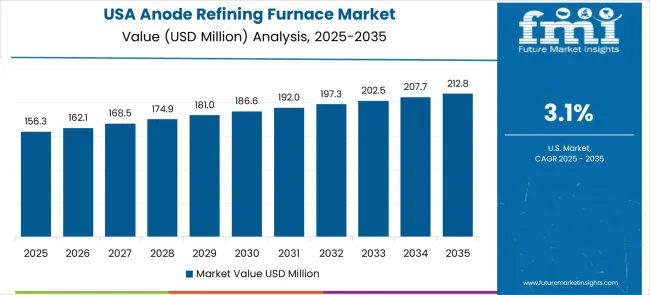
The United States market demonstrates steady and sustained growth with a 3.1% CAGR through comprehensive manufacturing sector revitalization and strategic reshoring initiatives bringing production back to domestic facilities. The market reflects an established industrial base with significant automation adoption trends and advanced metallurgical capabilities. Automotive sector modernization creates substantial demand for advanced copper processing equipment and high-performance anode refining systems meeting stringent quality requirements.
Aerospace industry leadership requires precision metallurgical applications for critical component processing and specialized high-temperature manufacturing procedures. Defense manufacturing sector maintains consistent demand for quality-certified processing procedures and advanced equipment specifications. Industrial automation adoption creates connectivity requirements for metallurgical equipment integration with sophisticated manufacturing execution systems.
Manufacturing competitiveness initiatives encourage substantial investment in efficiency-enhancing equipment and advanced metallurgical technologies. Quality standard compliance requires extensively documented processing procedures supporting comprehensive certification processes and regulatory adherence.
Market Dynamics:
The United Kingdom demonstrates market stability and resilience through comprehensive industrial modernization programs and strategic advanced manufacturing initiatives across multiple key sectors. A moderate 2.8% CAGR in market value reflects an established and mature manufacturing base, characterized by a strong emphasis on quality standards, precision engineering applications, and adherence to international compliance requirements. The aerospace sector, in particular, drives substantial demand for highly specialized precision metallurgical equipment used in critical processing operations, high-temperature manufacturing procedures, and component fabrication, where strict tolerances and material performance are essential.
In the automotive production sector, there is increasing reliance on precision processing equipment to ensure that components are manufactured and assembled according to rigorous quality and safety standards. Industrial equipment manufacturing also continues to maintain stringent quality standard requirements, supporting export-oriented competitiveness and the adoption of advanced technologies to maintain a leading position in international markets. Advanced manufacturing research and development initiatives further foster innovation, facilitating the continuous evolution of precision metallurgical equipment and high-performance processing systems.
Brexit-related trade considerations have created both challenges and opportunities, particularly for domestic manufacturing growth. The need for localized production capabilities has intensified demand for advanced metallurgical solutions and precision processing equipment, supporting the development of a more self-reliant industrial ecosystem. Government-led industrial strategy initiatives actively promote the adoption of advanced manufacturing technologies, investment in R&D, and the integration of innovative solutions that enhance production efficiency and technical capabilities.
Current Market Observations:
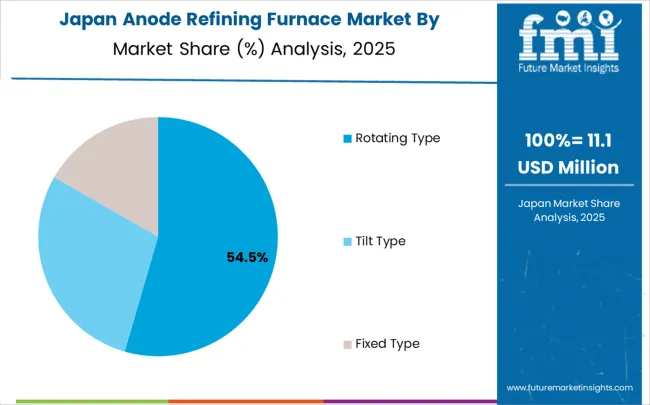
Japan maintains its position as a global leader in technological innovation through exceptional precision manufacturing capabilities and rigorous quality standard development across a wide range of industrial sectors. A 2.5% CAGR in market value reflects a mature and stable market, with widespread adoption of precision metallurgical equipment and sophisticated manufacturing technologies that consistently meet the highest industry standards. The automotive sector, in particular, sustains strong demand for advanced processing technologies and high-performance anode refining equipment, which are essential to meet strict quality control and production consistency requirements.
The industrial robot manufacturing sector also drives the need for precision processing equipment capable of supporting component production, assembly, and comprehensive testing applications, ensuring reliability and operational efficiency. Similarly, the electronics industry relies on highly specialized metallurgical processes for component fabrication, precision manufacturing, and materials treatment, which are crucial for maintaining performance and product quality. The development and enforcement of advanced quality management systems in Japan have also significantly influenced global metallurgical practices and technology adoption standards, establishing benchmarks for international production processes.
Japanese manufacturing technology exports are further strengthened by precision metallurgical equipment requirements for overseas production facilities and participation in technology transfer programs. Ongoing research and development initiatives continue to advance metallurgical processing methods, optimize equipment performance, and foster the creation of innovative applications that expand the functionality and efficiency of precision processing solutions.
Market Status Indicators:
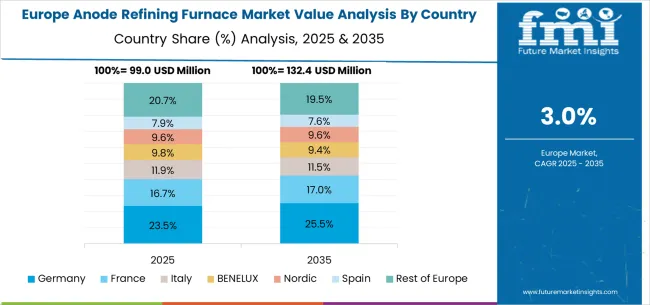
The anode refining furnace market in Europe is projected to grow steadily, supported by strong industrial demand for advanced metallurgical processing equipment. The market value in Europe is estimated at USD 89.3 million in 2025, with Germany leading the region with a 42.1% share, driven by its robust copper processing industry and advanced metallurgical equipment manufacturing capabilities. The United Kingdom follows with a 18.7% market share, benefiting from industrial modernization initiatives and stringent quality standards in aerospace and automotive sectors requiring precision copper components.
France holds 12.4% of the market, supported by expansions in renewable energy infrastructure and precision manufacturing investments requiring high-quality copper processing. Italy and Spain collectively represent 16.2% of European demand, spurred by infrastructure development projects and growing adoption of sustainable copper recycling technologies. The Rest of Europe, including Nordic countries, BENELUX region, and Eastern European nations, accounts for 10.6% of the market, backed by specialized metallurgical applications and expanding mining operations.
This diverse regional distribution highlights Europe's significance as a key market for anode refining furnaces, driven by evolving environmental regulations, technological advancement requirements, and stringent quality standards across multiple industrial sectors including automotive, aerospace, construction, and renewable energy applications.
The anode refining furnace market is highly competitive, driven by specialized metallurgical equipment manufacturers, advanced furnace solution providers, and global process technology companies. Market players are increasingly investing in research and development to enhance furnace efficiency, optimize high-temperature refining processes, and ensure precise control over metallurgical outcomes. Energy efficiency, environmental compliance, and process reliability are critical differentiators, as industries demand equipment that minimizes operational costs while maintaining product quality and regulatory adherence. Companies are leveraging technological innovation, digital process monitoring, and advanced automation systems to improve furnace performance and reduce downtime, enabling more sustainable and high-precision refining operations. Strategic collaborations and acquisitions are also key approaches for expanding product portfolios, strengthening regional presence, and enhancing technical expertise.
Leading players in the market include Metso Outotec, Tenova, Hatch Ltd., Danieli & C. Officine Meccaniche, SMS group, and Fives Group, each offering distinct capabilities in high-temperature furnace design and process optimization. Metso Outotec provides advanced refining solutions with robust process control and high operational reliability, while Tenova focuses on energy-efficient furnace operations and precision metallurgical control. Hatch Ltd. delivers innovative furnace systems emphasizing safety compliance, automation, and process performance. Danieli & C. Officine Meccaniche and SMS group specialize in integrated metallurgical processing solutions, offering high-performance furnace designs with advanced temperature management and process monitoring capabilities. Fives Group is recognized for its automation-oriented furnace solutions, combining operational efficiency with precision control to meet stringent industry standards. Other notable contributors, including Eramet Group, ABB, and Siemens, strengthen the market through technology integration, global service support, and equipment modernization.
Market competition is further intensified by the growing demand for environmentally sustainable and energy-efficient anode refining solutions. Companies are actively focusing on process innovation, digital integration, and predictive maintenance technologies to enhance furnace performance while minimizing carbon emissions and energy consumption. Collaborative initiatives between equipment manufacturers and industrial users enable customization of furnaces to specific operational requirements, thereby increasing reliability and refining quality. The ongoing emphasis on research and development, combined with strategic market expansion and global partnerships, positions these players to capitalize on growth opportunities and maintain leadership in the highly technical and performance-driven Anode Refining Furnace market.
The anode refining furnace market is central to copper industry excellence, metallurgical processing advancement, recycling infrastructure development, and sustainable mining operations. With increasing demands for processing efficiency, environmental compliance, and operational sustainability, the sector faces pressure to balance capital investment costs, energy consumption, and environmental impact measures. Coordinated action from governments, industry bodies, equipment manufacturers, copper processors, and investors is essential to transition toward environmentally sustainable, technologically advanced, and globally competitive anode refining systems.
How Governments Could Spur Local Production and Adoption?
How Industry Bodies Could Support Market Development?
How Equipment Manufacturers and Technology Players Could Strengthen the Ecosystem?
How Suppliers Could Navigate the Shift?
How Investors and Financial Enablers Could Unlock Value?
| Item | Value |
|---|---|
| Quantitative Units | USD 379.6 million |
| Equipment Type | Rotating Type, Tilt Type, Fixed Type |
| Application | Large-scale Copper Electrolytic Refining, Recycled Copper Smelting, Specialty Alloy Production, Others |
| Regions Covered | North America, Latin America, Europe, East Asia, South Asia & Pacific, Middle East & Africa |
| Countries Covered | United States, Canada, Mexico, Germany, United Kingdom, France, Italy, Spain, Nordic, BENELUX, China, Japan, South Korea, India, ASEAN, Australia, New Zealand, Brazil, Chile, Kingdom of Saudi Arabia, GCC Countries, Turkey, South Africa |
| Key Companies Profiled | SMS Group, Kumera, Metso, Hunan CHMM Metallurgy Engineering, Jiangxi Ruilin Equipment Co., Ltd., An Yutian, Outotec, CISDI Group, Tenova, Hatch Ltd, FLSmidth, Danieli Group |
| Additional Attributes | Dollar sales by equipment categories, regional demand trends across Asia Pacific, Europe, and North America, competitive landscape with player descriptions, adoption patterns across copper processing and recycling industries, integration with metallurgical manufacturing, innovations in furnace technology and automation control, and development of specialized applications with enhanced processing efficiency |
The global anode refining furnace market is estimated to be valued at USD 379.6 million in 2025.
The market size for the anode refining furnace market is projected to reach USD 525.1 million by 2035.
The anode refining furnace market is expected to grow at a 3.3% CAGR between 2025 and 2035.
The key product types in anode refining furnace market are rotating type, tilt type and fixed type.
In terms of application, recycled copper smelting segment to command 0.0% share in the anode refining furnace market in 2025.






Our Research Products

The "Full Research Suite" delivers actionable market intel, deep dives on markets or technologies, so clients act faster, cut risk, and unlock growth.

The Leaderboard benchmarks and ranks top vendors, classifying them as Established Leaders, Leading Challengers, or Disruptors & Challengers.

Locates where complements amplify value and substitutes erode it, forecasting net impact by horizon

We deliver granular, decision-grade intel: market sizing, 5-year forecasts, pricing, adoption, usage, revenue, and operational KPIs—plus competitor tracking, regulation, and value chains—across 60 countries broadly.

Spot the shifts before they hit your P&L. We track inflection points, adoption curves, pricing moves, and ecosystem plays to show where demand is heading, why it is changing, and what to do next across high-growth markets and disruptive tech

Real-time reads of user behavior. We track shifting priorities, perceptions of today’s and next-gen services, and provider experience, then pace how fast tech moves from trial to adoption, blending buyer, consumer, and channel inputs with social signals (#WhySwitch, #UX).

Partner with our analyst team to build a custom report designed around your business priorities. From analysing market trends to assessing competitors or crafting bespoke datasets, we tailor insights to your needs.
Supplier Intelligence
Discovery & Profiling
Capacity & Footprint
Performance & Risk
Compliance & Governance
Commercial Readiness
Who Supplies Whom
Scorecards & Shortlists
Playbooks & Docs
Category Intelligence
Definition & Scope
Demand & Use Cases
Cost Drivers
Market Structure
Supply Chain Map
Trade & Policy
Operating Norms
Deliverables
Buyer Intelligence
Account Basics
Spend & Scope
Procurement Model
Vendor Requirements
Terms & Policies
Entry Strategy
Pain Points & Triggers
Outputs
Pricing Analysis
Benchmarks
Trends
Should-Cost
Indexation
Landed Cost
Commercial Terms
Deliverables
Brand Analysis
Positioning & Value Prop
Share & Presence
Customer Evidence
Go-to-Market
Digital & Reputation
Compliance & Trust
KPIs & Gaps
Outputs
Full Research Suite comprises of:
Market outlook & trends analysis
Interviews & case studies
Strategic recommendations
Vendor profiles & capabilities analysis
5-year forecasts
8 regions and 60+ country-level data splits
Market segment data splits
12 months of continuous data updates
DELIVERED AS:
PDF EXCEL ONLINE
Silicon Anode Lithium Ion Battery Market Size and Share Forecast Outlook 2025 to 2035
Silicon Anode Battery Market Growth - Trends & Forecast 2025 to 2035
Silicone Anodes Market Size and Share Forecast Outlook 2025 to 2035
Aluminum Alloy Sacrificial Anode Market Size and Share Forecast Outlook 2025 to 2035
Refining Additives Market Size and Share Forecast Outlook 2025 to 2035
Oil Refining Market Size and Share Forecast Outlook 2025 to 2035
Alumina Refining Market Size and Share Forecast Outlook 2025 to 2035
Petroleum Refining Hydrogen Generation Market Size and Share Forecast Outlook 2025 to 2035
Lead Smelting and Refining Market Size and Share Forecast Outlook 2025 to 2035
Furnace Wall Sootblower Market Size and Share Forecast Outlook 2025 to 2035
Furnace Market Size and Share Forecast Outlook 2025 to 2035
Vertical Furnace Tube Cleaning Machine Market Size and Share Forecast Outlook 2025 to 2035
Induction Furnace Market Size and Share Forecast Outlook 2025 to 2035
Industrial Furnace Industry Analysis in Europe Forecast and Outlook 2025 to 2035
Industrial Furnace Market Size and Share Forecast Outlook 2025 to 2035
Laboratory Furnaces Market Analysis - Size, Share, and Forecast 2025 to 2035
Submerged ARC Furnaces Market Size and Share Forecast Outlook 2025 to 2035
Preheating Tunnel Furnace for Lithium Battery Market Size and Share Forecast Outlook 2025 to 2035
Atmosphere Roller Furnace Market Size and Share Forecast Outlook 2025 to 2035
Demand for Vertical Furnace Tube Cleaning Machine in USA Size and Share Forecast Outlook 2025 to 2035

Thank you!
You will receive an email from our Business Development Manager. Please be sure to check your SPAM/JUNK folder too.
Chat With
MaRIA